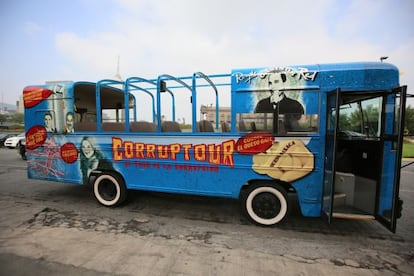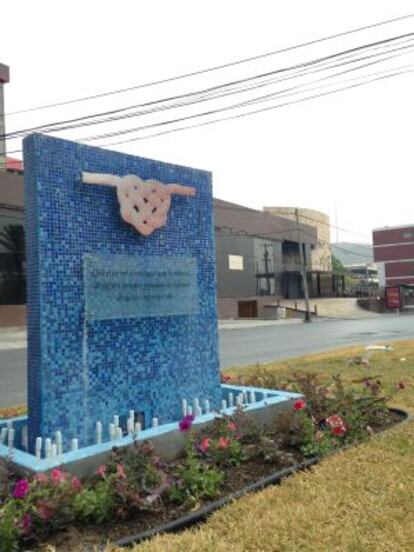Corruption: a tourist attraction in Mexico
New “Corruptour” bus in Monterrey explores the dark side of the city


Under a burning sun, a beat-up old bus rolls down the streets of Monterrey, in the northern Mexican state of Nuevo León. In a past life, it used to be an American school bus. But its yellow paint has been replaced by a bright blue hue, against which the faces of important local politicians vie for space with pigs and rats hugging bags of money.
The “Corruptour” shows visitors the evil deeds allegedly committed in Mexico’s second most important state. The idea came from Vía Ciudadana, a non-profit group that supports independent candidates to the midterm elections of 2015.
“This is like the jungle tour,” says one passerby as he stops in front of the bus. “You get on and watch the animals go by.”
The Corruptour bus makes 10 stops, the first of which is the Palacio de Gobierno, the state governor's workplace. The loudspeakers play a recorded message in which a man describing himself as blue-collar worker warns about rising debt levels in the state ever since Governor Rodrigo Medina, of the Institutional Revolutionary Party (PRI), took office in 2009. “In the time that this tour is completed, the governor will have spent two million pesos [$150,000] on his own image,” says the voice.
If we don’t wake up from our lethargy we’re going to be left without a country”
Edmundo Jiménez, local resident
The script for the tour has been written by an architect with a passion for history and it is based on irregular public spending worth a billion dollars detected by an audit. “Nobody has been called to account over that money,” says the recorded voice.
Edmundo Jiménez, 68, is one of the first citizens to try out this new attraction. He was widowed three years ago when his wife died in the fire at Casino Royale, set deliberately by criminals in one of the drug world’s worst attacks against civilians. Besides Rosa María Ramírez, another 51 people died at the local casino on August 25, 2011. “If we don’t wake up from our lethargy we’re going to be left without a country,” he says.
The ruins of the building are the next-to-last stop on the tour. Jiménez is indignant about the recently inaugurated memorial to the victims, a two-meter-high slab of concrete covered in blue tiles, with 52 plastic tubes sticking out of the bottom. The memorial goes by unnoticed in between two car lanes. “Look at the sign for that deputy,” he says, pointing at a giant billboard featuring the face of a National Action Party (PAN) lawmaker. “They have no shame!”
One of the brothers of Fernando Larrazábal, former mayor of Monterrey, also of PAN, was recorded accepting a wad of bills inside a casino shortly before the tragedy. The media reported corruption in the awarding of gambling licenses under the auspices of conservative governments. Larrazábal is now a federal deputy and a PAN strongman in the region. His face decorates one of the sides of the Corruptour.

City hall is another stop on the tour. “Politicians steal in broad daylight here,” says the recorded voice.
“Politics are too important to leave in the hands of politicians,” says Miguel Treviño, a member of Vía Ciudadana and one of the organizers of Corruptour. This group wants to ride the wave of citizen discontent with politicians to run in the 2015 elections, which for the first time will allow independent candidates to opt for mayoral and councilor positions. “We want the main topic next year to be corruption,” he adds.
Official statistics show that 84.4 percent of Mexicans believe politicians are corrupt. International organizations such as Transparency International rank Mexico 106th out of 177 countries on the Corruption Perception Index. It has held this position since 2012, given the lack of policies to fight dishonesty among elected officials.
People are starting to get curious about Corruptour. As the vehicle makes its way down the city streets, people laugh when they see rats and pigs together with PRI and PAN logos. Organizers say they are all booked up for September and October. The tour is free of charge and runs only on weekends.
“When is the next tour?” asks a lady in her seventies. Standing next to her, a younger woman says she has just arrived from the capital and would like to jump on the bus to get to know Monterrey. But the Corruptour will show them a side of the city that many do not want them to see.
Tu suscripción se está usando en otro dispositivo
¿Quieres añadir otro usuario a tu suscripción?
Si continúas leyendo en este dispositivo, no se podrá leer en el otro.
FlechaTu suscripción se está usando en otro dispositivo y solo puedes acceder a EL PAÍS desde un dispositivo a la vez.
Si quieres compartir tu cuenta, cambia tu suscripción a la modalidad Premium, así podrás añadir otro usuario. Cada uno accederá con su propia cuenta de email, lo que os permitirá personalizar vuestra experiencia en EL PAÍS.
¿Tienes una suscripción de empresa? Accede aquí para contratar más cuentas.
En el caso de no saber quién está usando tu cuenta, te recomendamos cambiar tu contraseña aquí.
Si decides continuar compartiendo tu cuenta, este mensaje se mostrará en tu dispositivo y en el de la otra persona que está usando tu cuenta de forma indefinida, afectando a tu experiencia de lectura. Puedes consultar aquí los términos y condiciones de la suscripción digital.
Últimas noticias
Most viewed
- Pablo Escobar’s hippos: A serious environmental problem, 40 years on
- Reinhard Genzel, Nobel laureate in physics: ‘One-minute videos will never give you the truth’
- Why we lost the habit of sleeping in two segments and how that changed our sense of time
- Charles Dubouloz, mountaineering star, retires at 36 with a farewell tour inspired by Walter Bonatti
- The Florida Keys tourist paradise is besieged by immigration agents: ‘We’ve never seen anything like this’








































